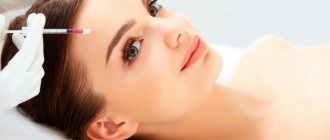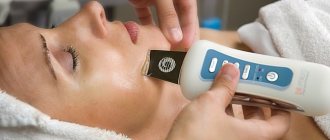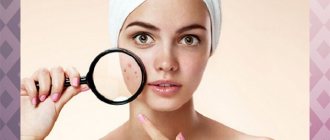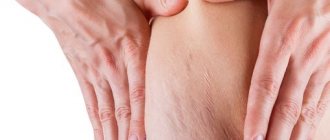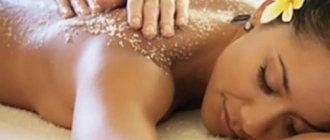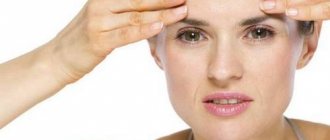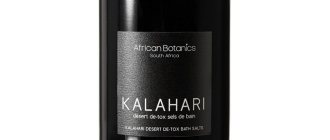Currently, in modern cosmetology there are a lot of procedures that help transform the skin on all parts of the body. One of the most famous and popular is superficial peeling. With its help, you can remove dead particles from the surface of the skin using special substances or devices. The procedure can be performed both at home and in a specialized cosmetology office. How peeling will be carried out depends on the characteristics of the skin. You can learn more about all the intricacies of peeling, its properties and cost by reading this article.
Superficial peeling
About peelings
Peeling has three types: superficial, medium and deep. It is easy to guess that their difference lies in the depth of action of the active components, which promote exfoliation of the stratum corneum and improve the formation of new cells. Peeling of the superficial type is the safest; it works gently on the skin, after which the skin quickly regenerates, which cannot be said about medium and deep peeling - in this case, rehabilitation will take much longer.
During the process of superficial exfoliation, the components act on the epidermis, due to which dead skin particles are separated. After the procedure, the speed of skin restoration increases, small wrinkles are eliminated, the skin on the face becomes fresh, smooth and healthy. Also, a peeling session helps fight rashes and other cosmetic problems. Superficial skin exfoliation can be performed in two ways.
- Impact at shallow depths. Peeling preparations only work on the surface layer of the skin.
- Impact at medium depth. Peeling works on several layers of the skin and also affects living cells.
Superficial peeling removes dead skin particles
Stages of the procedure
Stage one is preparatory. First, the cosmetologist cleanses the skin surface of cosmetic residues and dirt particles using a soft gel and foam. After this, the skin is degreased with a special lotion. Sometimes a gel with a small concentration of acids is applied before the main product to prepare the dermis for intense acid exposure.
Stage two is the main one. At this stage, the active composition is directly applied to the epidermis. The cosmetologist can apply it in two ways. The first is with light and quick movements, this is a more gentle method. The second is more aggressive, using a cotton pad and pressing on the skin surface. The retention time of the drug depends on the condition of the epidermis and the expected results.
Stage three – neutralizing . During this procedure, a special gel is applied to neutralize the effect of the acid. After this, all drugs are thoroughly removed with warm water.
Stage four – final . After the main procedure, a soothing and nourishing mask is applied to the face, followed by a light cream.
In the video you can see how superficial chemical peeling is carried out in a beauty salon:
Types of superficial skin exfoliation
There are four ways to perform superficial exfoliation of the skin - physical, biological, chemical and mechanical. Each method has its pros and cons. How accurately and deeply the peeling session will be carried out depends on exactly how it will be performed. Let's look at the types of peeling in more detail.
Mechanical . The simplest method of performing superficial exfoliation. Representatives of the fair sex have the opportunity to carry out the procedure themselves or visit a cosmetologist. Peeling is carried out using scrubs, which include salt, sugar and other components. Such scrubbing products contain solid abrasive particles - they delicately separate dead skin cells. In a salon setting, peeling can be carried out using hardware, but this procedure has not gained popularity due to painful sensations.
Note! Specialized creamy textures - gommages - are also quite often used for the purpose of superficial peeling; in addition, they are used to massage the facial area.
Scrubs can be used for superficial peeling
Physical . Such peeling can, as a rule, only be carried out in a salon, because it is carried out using hardware. Exfoliation of the skin involves equipment that produces ultraviolet light, ultrasound, liquid nitrogen, carbon dioxide, and steam. This type of peeling can be performed using a laser beam - this method helps the active components penetrate more accurately.
Note! Ultimately, it is possible to treat each individual skin layer at different depths.
Superficial peeling can also be carried out using devices
Biological . The session is carried out using enzymes. The substance contains a protein enzyme - it increases the speed of reactions occurring in the layers of the skin, as a result of which renewal processes are accelerated.
Chemical . Fruit acids take part in this type of peeling. If the procedure is carried out correctly, the skin tissue is not damaged. Acid components have an effect on skin tissue, activate exfoliation and further cellular regeneration. The most popular chemical peels are malic, lactic, glycolic and tartaric acids.
Note! For example, glycolic acid helps collagen production, has antiseptic and antioxidant properties - all this has a beneficial effect on aging skin.
Peeling is often done using fruit acids
Cosmetologists often perform the following superficial peels.
- With the participation of alpha hydroxy acids. This exfoliation is gentle, effective and safe. The most popular is a concentration of 30-70%, pH 0.1-3.0. During the session, erythema and peeling are sometimes noted. After 2-3 days, these symptoms will go away on their own.
- With the participation of glycolic acid. This type of exfoliation not only removes dead skin but also enhances collagen production and release. The session will help normalize the moisture level of the epidermis, even out the complexion, and eliminate the proliferation of bacteria. Representatives of any age category can resort to such peeling. After the session, small wrinkles are eliminated. Immediately after the procedure, redness of the skin is often noted, but there is no need to worry - it will go away on its own after 3-4 hours.
- With the participation of retinoic acid. This procedure does not injure the skin, and the result will be the same as after an intermediate facial peeling. This method is needed to combat involutional changes in the layers of the epidermis. The session eliminates rosacea well, but will not help remove wrinkles that appear due to active facial expressions.
Retinoic acid is also used
Superficial exfoliation of the skin should be carried out by a cosmetologist with extensive experience - only then the procedure will be as safe and non-traumatic as possible.
Note! Women during pregnancy and breastfeeding should consult a doctor before the procedure.
Operating principle
As the name suggests, this type of chemical peel only affects the surface of the epidermis, and this has its pros and cons. Although, in principle, by adjusting the concentration and residence time of acids, which are the basis of almost all peeling preparations, the doctor can also make a medium or deep peel. They are already classified as therapeutic and rejuvenating procedures, but after them there is a period of active rehabilitation with numerous restrictions.
Superficial peeling does not damage the skin. The concentration of acids is so weak that they only dissolve dead skin scales from the upper layer of the epidermis and practically do not irritate the skin. Accordingly, the patient does not experience pain during the procedure.
The correct choice of the drug allows you to obtain some additional effects, which are a pleasant bonus to the primary task of surface peeling - cleansing.
Exfoliating the skin with chemicals
This type of peeling is called “lunch peeling”. It is quite gentle on the skin compared to other chemical peels; it does not require long and complex preparation, and there are no traces left after it.
During the process of superficial peeling, old cellular units are separated. The thickness of their layer is approximately 0.06 mm, but this is already enough for the face to become noticeably fresher, the condition of the skin to improve, inflammation to decrease, shallow wrinkles to level out, pigmentation to become less pronounced, and pores to decrease in size. In order for the result to last longer and be more pronounced, it is necessary to perform a course peeling approach. It involves repeating sessions every few weeks (the required number of sessions is prescribed by the doctor).
Note! The duration of a peeling session is about 10-30 minutes; there is no pain during the process, but it may sting and burn the skin a little.
Despite the superficial effect, the result is clearly visible
Superficial exfoliation of the skin is often impossible without the use of products whose active components are fruit acids. They are also called AHA (alpha hydroxyl). AHA exfoliation includes, for example, almond peeling - the substance used in this peeling includes acid obtained from bitter almonds.
Superficial exfoliation can also be done with glycolic acid. Its huge advantage lies in the very small size of the molecular particles - they easily penetrate the protective layer of the skin without injuring it, and trigger the stimulation of active collagen production.
Superficial exfoliation works well on young skin (20-35 years old) even when there are no serious deficiencies, but only sebum secretion and oily sheen, local inflammation and slight pigmentation are of concern. Currently, the cosmetic market offers a wide variety of kits designed for superficial peeling at home, and you can choose an option in any price category.
Note! Manufacturers provide information that the use of such products provides 30% of the results that can be achieved in a beauty salon.
You can carry out the procedure at home, but the result will not be very pronounced.
The middle place is given to retinoic and salicylic skin exfoliation (BHA). They are classified as “superficial-medium” peels because they can work in deeper layers of the skin compared to fruit acid peels. However, this does not cause injury to the skin, so this peeling is appreciated by patients. The Jessner Peel is an exfoliating procedure performed using a mixture of retinoic, lactic and salicylic acids, and is quite often used in some beauty salons.
A superficial Jessner peel may be performed.
Types and indications
Superficial chemical peeling cleanses the skin of the top layer of keratinized cells, which are responsible for most epidermal problems. Pimples, blackheads, acne, expression lines - these are all symptoms of the need to cleanse the stratum corneum from the accumulation of dead cells, dirt and sebum.
Surface peeling is classified according to the main active ingredient. Depending on the indications, the necessary ingredient for the session is selected. It can be carried out with acids, mechanical components (powders, crushed plants), laser, fruit juices and even wine. Kinds :
- Glycolic superficial-medium peeling is performed with the same acid. As the name implies, it acts on two layers at once, thanks to which it allows you to get rid of serious problems. These are wrinkles, acne, post-acne and age spots. Among its advantages are accessibility and low-invasiveness. Unlike the overwhelming number of other similar procedures, it is suitable for all skin types and does not require long-term rehabilitation. It is represented on the professional market by Filorga Glykopeel cosmetics;
- Coral , by and large, is a mechanical, not a chemical, peeling. Crushed coral particles are applied to the previously cleaned epidermis along with the active ingredients. These can be oils, professional or medicinal solutions and acids. Abrasive particles deeply cleanse pores, eliminating dust and sebum accumulation. The effect is noticeable after the first use. This procedure is prescribed to even out complexion, cleanse the skin, normalize the functioning of the sebaceous glands and remove scars and stretch marks. The disadvantages include a long recovery period - more than a week. Its analogue is homemade soap solution from Christina;
- Salicylic peeling performed with the most famous acid in cosmetology. Its main difference from the others is that it does not remove dead cells mechanically and does not roll them off, but simply dissolves them. This allows you to use the solution even on non-problematic and sensitive skin. Main indications: acne, blackheads, the need to normalize sebum secretion. With this product you can achieve completely clean and perfectly smooth skin. The effect is most noticeable after 3 procedures;
Salicylic peeling - Superficial retinoic or yellow peeling used to treat acne and scars. This type of procedure is two-phase, i.e., it is carried out in several approaches. The most important role in achieving the desired effect is played by cleansing the epidermis. Afterwards, one layer of retinol is applied to the skin, followed by a second one after a while. It is used for both face and body. Depending on the time the solution is left on the epidermis, you can remove stretch marks, scars, pimples, improve skin color and eliminate expression wrinkles. There are superficial, deep and middle;
Yellow - Almond is the softest peeling of all existing ones. Thanks to its gentle action, it can be used even during pregnancy and breastfeeding. The main purpose is to treat wrinkles and minor skin problems. A solution of mandelic acid is applied around the eyes, décolleté, neck and other problem areas. After some time, the mixture is washed off. A distinctive feature is the minimal rehabilitation period and high efficiency. The effect is noticeable after the first session;
- Laser ABR peeling unlike any other species. It uses a fractional laser to eliminate acne and scars. The action is based on increasing the temperature at certain points that need treatment. The laser beam burns out diseased and dead cells, accelerates skin regeneration and metabolism;
Laser - TCA peeling (TCA or AHA) with fruit acids acts similarly to salicylic acid, but more gently. The procedure is based on the natural properties of certain plant acids to dissolve dead cells. Wine, apple, grape and others are used. A distinctive feature is that it can be done even by teenagers, because it does not damage healthy cells in any way. These include Danne, Mattioli, DMKcosmetics cosmetics;
- Jet Peel or gas-liquid gentle peeling carried out using saline or various anti-aging drugs (hyaluronic acid, for example). It involves injections, as a result of which the skin itself gets rid of unnecessary cells. Has a rejuvenating and renewing effect. Helps against peeling, problem skin, acne and post-acne. The effect is quick, but not long-lasting;
Photo – Jet Peel - Jessner peeling is another gentle type of skin treatment that is performed with a mixture of several acids. It disinfects the surface of the epidermis, promotes accelerated cell regeneration and restoration of normal functioning of the sebaceous glands. It is used to treat a variety of problems, including chronic skin diseases. Most often performed with INNO-PEEL and Perfeitopeel mixtures;
- Superficial phenol peeling Known for removing the entire stratum corneum of the skin. More often used as a deep one. After using carbol, the entire face turns into one large burn, which heals over time with a completely renewed epidermis. It is used to obtain anti-aging effects: eliminating wrinkles, tightening, removing age spots;
Photo – Phenol peeling - Lactic acid treatment is also an example of a lifting peel. Prescribed for increased pigmentation, wrinkles, deep scars and sagging epidermis. The main advantage is that the procedure helps the skin restore its protective functions and metabolic processes. Due to this, it quickly regenerates. It is carried out with the drugs Argipil and Mediderma.
Indications for superficial peeling:
- Acne, blackheads, acne, post-acne;
- Keloid scars, scars and stretch marks;
- Expression and age wrinkles of varying severity;
- Age spots, freckles;
- Skin irregularities, gray complexion, bumps;
- Sagging areas, loss of turgor, decreased metabolic processes in the skin, disruption of the sebaceous glands.
Who is recommended for superficial peeling?
Any procedure performed by a cosmetologist has indications for its implementation. Peeling can be used for any skin type - dry, oily, combination - there are no restrictions.
If there is increased oiliness of the skin, sessions should be performed more often than in the case of a normal or combined type.
Note! The fair half of humanity can perform superficial peeling of the facial area once every 14 days, and of the body - once every 7 days.
If your skin is oily, it is recommended to exfoliate more often.
When is superficial peeling required:
- if the patient has increased oiliness of the skin, skin prone to inflammation;
- for medicinal purposes in the fight against acne;
- to reduce pore sizes;
- to eliminate age-related defects of the skin;
- to reduce age spots;
- with seborrhea;
- for the purpose of post-acne correction.
There are certain indications for such peeling
At the end of the session, you can immediately notice positive changes: the surface of the skin is smoothed, leveled, mild wrinkles are eliminated, color is improved, the face once again glows with health and beauty. Exfoliation is necessary to eliminate cosmetic imperfections of the skin, as well as to prevent enlarged pores and the occurrence of acne.
It should be noted that it is possible to obtain a long-term effect from superficial peeling only if it is repeated frequently. The duration and number of peeling sessions are determined by the cosmetologist, based on the condition of the patient’s skin and his age category.
During the period after the procedure, it is necessary to provide the skin with appropriate care and protect it from external unfavorable factors: UV radiation, cosmetics, mechanical trauma (epilation).
Note! If you follow this rule, the recovery period will proceed quickly and easily.
After the procedure, it is important to carefully care for your skin.
How to care for your skin after peeling
After superficial peeling, the skin needs increased care, since exposed young cells are not yet able to counteract the negative effects of the environment. Care includes the following rules:
- it is necessary to regularly use a protective cream with an increased level of sun protection factor;
- prolonged exposure to the sun should be avoided;
- to accelerate regeneration, it is recommended to use healing pharmaceutical products with panthenol or bisabolol;
- it is necessary to regularly make moisturizing masks and drink about 2 liters of water per day, since after the procedure the skin becomes dehydrated for some time;
- You should temporarily give up makeup;
- after a course of superficial peelings, scrubs, aggressive cleansers and alcohol-containing tonics should not be used;
- It is prohibited to visit the swimming pool, bathhouse, sauna.
Important: The cycle of complete restoration of the epidermis is 28 days. It is during this period that your skin needs additional protection.
Superficial peeling is one of the safest methods of facial cleansing only subject to careful post-procedure care and proper selection of the concentration of the drug.
Benefits of superficial peeling
Superficial peeling has a lot of useful properties, which is why the fair sex loves this procedure and constantly resorts to it.
Without pain . The active substances work on the surface of the skin, and this does not cause pain - only a minimal burning sensation is possible.
Short-term rehabilitation . The skin returns to its previous appearance in just a couple of days, redness and peeling go away quite quickly, which cannot be said about deep peelings.
Rehabilitation after this procedure does not last long
There is no seasonal restriction on the procedure . Superficial peeling can be performed all year round. During the period of active solar radiation, it is necessary to limit the effect of sunlight on the skin - the use of sunscreen will be required.
Harmlessness. The likelihood of severe injury to the skin in the form of burns during a peeling session is minimized.
Before going for a superficial skin exfoliation procedure, women need to remember that after the cosmetologist’s manipulations, redness, dryness and peeling of the skin may appear. This skin behavior is considered normal; unpleasant symptoms will go away after a couple of days.
Note! Mistakes made during the procedure and negligent attitude to contraindications are fraught with unpleasant consequences - the condition of the skin tissue may worsen and pigmentation may increase.
Side effects may occur for some time
Preparatory care
The benefits of superficial chemical peels will only occur if proper care is taken before and after the procedure. There is a basic list of actions to prepare for this event:
- A few days before peeling, the face should be lubricated with a weak acid solution to protect against burns and prepare the skin.
- Anti-tanning creams are sometimes used.
- Experts often recommend using cosmetic products with salicylic acid.
Incorrect or lack of preparation may result in burns. Negative consequences include roughness of the skin or, conversely, severe vulnerability.
Contraindications
Anyone who wants to peel their skin should be aware of the contraindications to this procedure. If the patient does not take them into account, he will not receive the desired effect from the session; rather, on the contrary, the skin condition may worsen, the risk of burns, increased age spots, progression of acne, and others increases. Superficial peeling may be contraindicated in such cases.
- Acute viral diseases (herpes).
- Acne has worsened.
- There are purulent inflammations on the skin.
- There is an allergy to the skin.
- Combined use of aromatic retinoids.
- Recently, before the peeling procedure, other cosmetic procedures were performed that could damage the skin.
- Damage in the form of cuts and abrasions.
- There is a risk of intolerance to the active substances of peeling preparations.
The procedure has contraindications
Types of peeling in cosmetology by depth and type of action
Types of facial peels in cosmetology are divided depending on the active ingredients and method of exposure.
There are two types of salon cleansing processes:
- depth of penetration - depends on the thickness of keratinized particles;
- execution technique - has different methods of influencing the skin, products, components, equipment used during the session.
Human skin consists of epidermis (superficial layer), dermis, subcutaneous fatty tissue (deep layer). Fibroblasts are considered the main cells of the main layer of the dermis. They are designed for the synthesis of collagen and elastin fibers.
Surface
It is carried out using lactic and fruit acid, does not penetrate into the deep layers of the dermis, and is safe. There is no pain during the cleansing process. The procedure is carried out with complex correction, since during cleansing the active substances from cosmetic products penetrate the skin faster.
In the first minutes after cleansing, the skin becomes red and peels. After several days, the keratinized cells begin to peel off in layers, the pores tighten, and the inner radiance of the dermis is observed.
Superficial peeling has the following effect:
- gives the face a healthy color;
- whitens pigmentation;
- eliminates yellowness;
- evens out the terrain;
- reduces pronounced defects;
- prevents fine wrinkles.
The procedure is widely used to treat dry skin problems. For this purpose, formulations with biostimulants, vitamins, bleaches, and moisturizers are used. The active ingredients reduce the likelihood of inflammation, swelling, and burning.
Median
As a result of cleaning, all epidermal tissue is removed down to the papillary layer. Cleansing is carried out using trichloroacetic, salicylic, and retinoic acids.
The use of peeling is prohibited during the active phase of inflammatory processes on the dermis - cleaning will increase the spread of the rash.
Medium peeling has the following effects:
- improvement of complexion;
- increased dermal turgor;
- elimination of pigmentation;
- removal of scars, post-acne.
Cleansing sessions are strictly not recommended for women aged 35-50 years. Peeling is carried out in the autumn-spring period, during low sun activity. With strong ultraviolet rays, there is a possibility that pigment spots will increase after the procedure.
Deep
It is more painful because the epidermal tissue is damaged during the session. The procedure is carried out in a hospital setting, under anesthesia, in the presence of a resuscitation team. Rehabilitation lasts 1-3 months. The main active component of the product is phenol. Its use in the neck, chest, and back areas is fraught with the appearance of scars.
Immediately after the session, the face swells and becomes covered with bright red spots and crusts. It is strictly not recommended to pick off keratinized particles after peeling - this leads to scarring. Within a month, the redness does not go away; in the second month, the face becomes soft pink, after which it takes on a normal appearance.
The effectiveness of deep cleaning includes:
- pronounced facelift;
- smoothing wrinkles;
- healthy glow of the face;
- removal of pigment spots.
Among the negative points it is worth highlighting:
- hyperpigmentation;
- the likelihood of an infectious process, inflammation;
- manifestation of allergies;
- the presence of scars and scars.
Cosmetologists do not recommend deep cleansing for herpes, kidney failure, diseases of the urinary and cardiovascular systems. The depth of penetration of active substances determines the duration of recovery and rehabilitation.
Superficial peeling as a salon procedure
Skin exfoliation in a beauty salon will not be limited to one visit. After an in-person consultation and assessment of the condition of the skin, the doctor will determine the required number of peeling sessions. Typically this number of sessions varies from 6 to 10.
Note! Between sessions it is necessary to maintain an interval of 14 days.
What is the procedure for a session in a salon:
- the first step is to clean the skin, then steam it to expand the pores;
- application of the peeling preparation. The substance is applied using a cosmetic brush or a cotton swab. A tingling or burning sensation may appear, but there is no reason to worry, since this is the skin’s natural response to the irritant. When 5-10 minutes have passed, the cosmetologist will remove the drug from the face;
- The session ends with a light massage of the treated area and applying a nourishing cream to it.
The procedure is carried out in several stages
At home
Peeling can be done at home thanks to affordable products that are sold in pharmacies. Although this does not require the presence of a cosmetologist, there are still some tips to consider before performing this cleaning. Typically, superficial peeling is performed with lactic acid or fruit acids - strawberry, malic, citric.
When it is necessary to eliminate dead cells and pigmentation, you should use glycolic acid or a medium peel. In order not to confuse anything and not harm the skin, you need to buy the finished product at the pharmacy. You just need to use it after reading the instructions. You should pay attention to the composition, as there may be some components that cause individual intolerance.
Before use, you should check the safety of the drug. This is done like this: a little product is applied to the skin that is especially sensitive - the elbow or the area behind the ear. You need to leave it for 5-10 minutes. If redness appears, the procedure should not be performed. If no unpleasant moments occur, then the product is ideal.
Compared to salon peeling, superficial peeling performed at home, due to the low concentration of acids, is considered a safe and easy way to cleanse the skin. For oily epidermis, it is recommended to do the treatment every week. If the skin is dry and sensitive, then peeling is carried out every month.
A few minutes after applying the product there will be some tingling sensation. This is due to the effects of acid. The duration of the procedure is usually indicated in the instructions; it is better not to violate it, since burns and other negative consequences are likely to occur. After the procedure is completed, the product is removed from the facial skin by rinsing with warm water. There may be some redness of the skin for the first 10-20 minutes after treatment. For home peeling, a product is prepared based on coffee grounds or ground natural coffee, sea salt and oils.
How to do superficial peeling yourself?
Any girl can perform mechanical superficial peeling on her own at home. For this purpose, scrubbing products purchased at a cosmetics store are used, or folk recipes can be used. Typically, mechanical peeling at home is carried out according to the following scheme: cleansing the face, then applying a scrub, massaging the skin, washing. In this way, dead particles are removed from the skin.
Note! The procedure must be completed by applying a nourishing cream.
Who needs peeling
Superficial peeling is not able to solve complex age-related imperfections and skin problems, but it can partially correct them, invigorate weakened epidermal cells and strengthen intracellular processes.
It is recommended to perform peelings if the following indications exist:
- the first wrinkles and signs of early aging of the integument;
- acne, problematic pimples and acne on the face;
- clogged and enlarged pores, increased skin oiliness;
- unhealthy complexion, unusual grayness and dullness;
- weakening of tissue tone and elasticity;
- skin pigmentation, freckles that the client would like to get rid of;
- some dermatological diseases (folliculitis, seborrhea and others);
- comedones and blackheads.
Superficial cleansing of the face can be carried out for preventive purposes or before more complex cosmetic procedures (for example, before laser, phenol peeling or surgery).
Home peeling recipes
Homemade recipes are used to make your own mixture for superficial skin exfoliation. The choice of active ingredients depends on the type of skin.
Varieties of home peeling.
- Peeling with salt for oily skin types. One tablespoon of cream should be combined with one teaspoon of table salt. Apply the mixture to the face and wash it off after 20 minutes.
- Glycolic peeling for dry skin types. Mix yogurt and white sugar in a 1:1 ratio and cover your face with the mixture. After 20 minutes, the peeling is removed.
- Oatmeal peeling for combination skin. A small amount of water is mixed with chopped oatmeal and covered the face area. After several minutes of massage movements, the mixture is washed off.
You can make your own peeling agent
What is peeling
Peeling is a set of methods that completely or partially remove the stratum corneum in order to rejuvenate or correct external imperfections. Dead particles of the epidermis exfoliate, collagen or elastin begins to be synthesized in the cells, due to which young cells appear.
Facial peeling in cosmetology for skin treatment and rejuvenation
To rejuvenate and smooth the skin, cosmetologists use a cleansing mixture technology using trichloroacetic acid, phenol, and resorcinol.
Types of facial peels in cosmetology have the following purpose:
- cure acne, pimples;
- refresh aging skin, restore its elasticity;
- eliminate external defects such as scars, scars, stretch marks;
- stop the appearance of facial wrinkles, smooth them out;
- whiten hyperpigmentation, keratoma;
- eliminate papilloma.
The most popular areas for cleaning are the face, neck, chest, and back. The effectiveness of the procedure is dictated by the method and depth of penetration of the cleansing mixtures.
Reactions that occur after the procedure
Even properly performed delicate peeling can cause possible unwanted skin reactions. These include:
- prolonged redness of the skin;
- the appearance of small swelling;
- peeling of the skin;
- the appearance of pigmentation.
Side effects sometimes occur
Note! If you peel using a laser beam, the likelihood of these reactions increases. In addition, a gauze effect, hemorrhage and worsening of skin diseases may occur. Mechanical and chemical cleansing of the skin rarely causes side effects.
Hardware peeling
It is carried out with a special apparatus with a liquid solution that helps eliminate dead epithelium. Cleansing does not cause pain, discomfort, and does not provoke allergies. Increased sensitivity is possible immediately after the session.
During cleaning, the following is eliminated:
- stretch marks, scars;
- acne, pimples;
- wrinkles, age-related changes;
- freckles;
- bruises, swelling;
- seborrheic dermatitis.
Hardware manipulations are prohibited when:
- diseases of ENT organs;
- viral, infectious pathologies;
- formations of unknown origin.
With the correct mechanical effect on the epidermis, cells are renewed, pores are smoothed, lymph outflow improves, and metabolic processes are accelerated. Hardware manipulations are performed on any type of dermis.
Ultrasonic
With superficial ultrasonic cleaning, dead epithelium is removed and the pores are cleansed. Ultrasound is used to prepare the dermis for manual cleaning, mesotherapy, massage, and care programs. But it can be used as an independent procedure.
The mechanism of action is an ultrasonic wave emanating from the device. Sound waves knock out fat accumulations, particles of dirt and dust. Due to the effect of cavitation, airless bubbles are formed on the surface of the epidermis. This softens and loosens the epidermal tissue.
The procedure is used in cases of photoaging, peeling, dryness, dull, oily, combination skin. The session is not carried out in case of individual intolerance to the components of the product, pregnancy, high temperature, abrasions, scratches, infectious and inflammatory processes.
Laser
Occurs with the help of laser beams. The result is determined by the type of irradiation and the depth of penetration of the beam into the tissue. Laser types of facial peels differ from each other.
Laser peeling can be:
- cold – affects the upper layer of the dermis. In cosmetology, it is used for layer-by-layer removal of tissue without preheating the lower cells. The skin after the session becomes smooth, matte, velvety;
- hot – the stratum corneum is cleansed. When tissue is removed layer by layer, the underlying structures are heated and metabolic processes are stimulated. After cleansing, the elasticity of the dermis increases, small, median wrinkles are smoothed out;
- in the form of laser resurfacing – penetrates into the deep layers of the epidermis. By destroying the old base of the dermis with a laser beam, the cells are renewed and collagen and elastin fibers begin to be synthesized. As a result of cleansing, a rejuvenating, lifting effect is observed.
Laser peeling is not performed for cancer, cardiovascular diseases, infectious processes, pregnancy, or autoimmune diseases.
Vacuum
It occurs using a device that creates a vacuum effect upon contact with the epidermis. As a result, pores are cleaned, tone increases, and skin color improves. The procedure is widely used to clean specific areas. The manipulation is painless, lasts 15-20 minutes, does not cause addiction and deterioration of the epidermis after stopping the sessions.
Vacuum cleaning is not carried out if:
- acute dermatitis, chronic skin diseases in the acute stage;
- viral infections such as herpes;
- rosacea;
- rosacea, capillary fragility and other vascular pathologies;
- increased dryness and sensitivity of the dermis.
Cosmetologists recommend vacuum peeling for adult skin. Thanks to improved lymphatic drainage, blood circulation and metabolic processes are accelerated, toxins and free radicals are eliminated.
The result obtained after the procedure
The effects of the sessions are:
- increased skin tone;
- reduction of pore sizes;
- replenishment of moisture and nutritional environment in the skin;
- the superficial skin layer is leveled;
- reduction of shallow wrinkles;
- regulation of skin oiliness;
- reduction of inflammatory rashes;
- improvement of the color of the facial area;
- rejuvenating effect.
This procedure provides excellent results
Note! The final result of the procedure will not appear immediately. And yet, after the first session, an improvement in the condition of the skin is noted.
Chemical peeling
The technology is based on the use of chemicals and acids. During the session, the skin gets burned, the top layer dies off, giving way to deep cellular layers.
Most often, chemical peeling is prescribed for:
- problematic skin;
- acne, pimples;
- age spots;
- loss of elasticity, firmness;
- photoaging;
- deep, enlarged pores;
- wrinkles;
- dullness of the dermis.
Cleaning occurs through various acids such as glycolic, lactic, salicylic. When they come into contact with the epidermis, they eat away dead cells and accelerate their renewal. Depending on the composition, the product eliminates external defects. Due to the stressful environment during the session, the skin turns on its protective mechanism, thereby accelerating regeneration.
Enzymatic
Of all chemical peels, it delicately and gently cleanses the epidermis. Enzymes (special enzyme substances) in the cleansing mixture improve the condition of the endocrine and immune systems, improve blood circulation, and make the skin more elastic. The cleaning procedure is suitable for any type of epidermis, deeply cleanses pores, and prevents acne.
The effect is visible after the first session:
- the skin is cleansed and becomes smooth;
- relief is smoothed out;
- pigmentation whitens;
- scars are removed;
- complexion improves.
All subsequent cleansing will consolidate success and maintain the healthy state of epithelial tissues. When combining peeling with daily cleansing and moisturizing procedures, the result will be noticeable after a month.
Acid
Cleansing the dermis with glycolic, lactic, salicylic, and fruit acids is used for:
- removing dead particles;
- elimination of external defects;
- stimulating defense mechanisms;
- production of collagen and elastin fibers.
Chemical acids destroy dead cells and remove fat accumulation. During the cleaning process, regenerative processes are activated, accelerating tissue restoration and healing.
The most popular are cleansing mixtures containing glycolic, lactic, pyruvic, and citric acid. They are suitable for any type of dermis. A mixture with mandelic, salicylic, and azelaic acids is suitable for oily epidermis. Dry skin is cleansed with lactic and glycolic acid.
Combined
Combining several acids allows you to cope with several problems. It is important to choose the right proportions of active substances, otherwise you can aggravate the problem and burn the skin. The most common peeling compositions are alpha hydroxy acids and beta hydroxy acids.
Alpha hydroxy acids (AHA) do not cause burns, exfoliate horny scales, and interact with intercellular contacts in the dermis. A high level of ANA is dangerous due to epidermolysis, but the level of trauma to epithelial tissues is much lower than with other purification technologies.
Cost of the procedure
The price for the procedure will directly depend on the type of impact and the means used. We will indicate the approximate cost of different types of surface peeling.
| Type of procedure | Cost of one procedure |
| Chemical superficial peeling | 1800 rub. |
| Physical superficial peeling | 2000 rub. |
| Biological superficial peeling | 3100 rub. |
| Mechanical superficial peeling | 1700 rub. |
Reviews
Olga, Voronezh
“I really love superficial peels because you don’t have to suffer the consequences, but still remove small problems. With its help, I make my skin fresher, reduce pores, and remove oily shine. I love chemical superficial peeling the most and recommend it to everyone.”
Patients love the superficial peeling procedure for its quick recovery and dramatic effect.
Taisiya, Kaluga
“I regularly do mechanical superficial peeling procedures - if I have time, then once every two weeks. This helps me keep my skin in excellent condition: it becomes lighter, and it is easier to “work” with it using masks. I think that later I’ll try other methods of superficial peeling, because after other, deeper effects I have to recover for some time, but here I can immediately run about my business.”
Expected effect after cleaning
Superficial peeling for the face has a multifaceted, beneficial effect:
- frees the skin from dead cells, keratinization and sebaceous plugs;
- normalizes skin breathing;
- enhances the effect of cosmetic products used in daily facial care;
- smoothes out small wrinkles, folds, scars;
- activates the synthesis of natural collagen, thereby increasing the tone and elasticity of the fibers;
- has a therapeutic and anti-inflammatory effect;
- dries out acne;
- stabilizes the functioning of the sebaceous glands;
- evens out the shade of the epidermis, making it fresher and healthier;
- accelerates blood microcirculation and metabolism in epidermal cells.
The final result, just like peeling, is superficial. The purpose of the procedure is to prevent the problem from occurring and facilitate its elimination, so there is no need to rely on a miraculous facial transformation.
If you suffer from a specific skin problem, choose a peel with purpose. For example, exfoliation with salicylic acid is ideal for those with a problematic type of epidermis, because the acidic agent has a pronounced drying, antimicrobial and anti-inflammatory effect. But for dry skin and the first signs of early aging, it is better to use milk peeling, because lactic acid intensively moisturizes tissues and has a rejuvenating effect.
In general, freshness, healthy radiance, softness and lightness of the skin after a course of peelings are guaranteed. These pleasant changes in the client will not leave the next 4-6 months.
